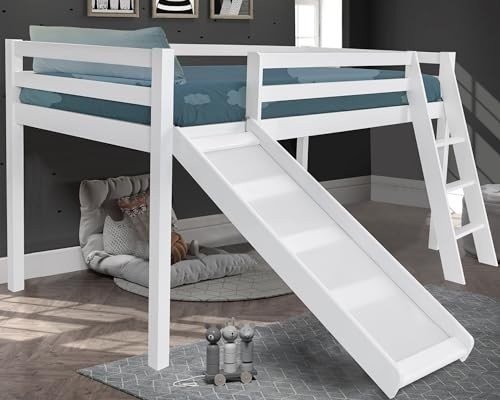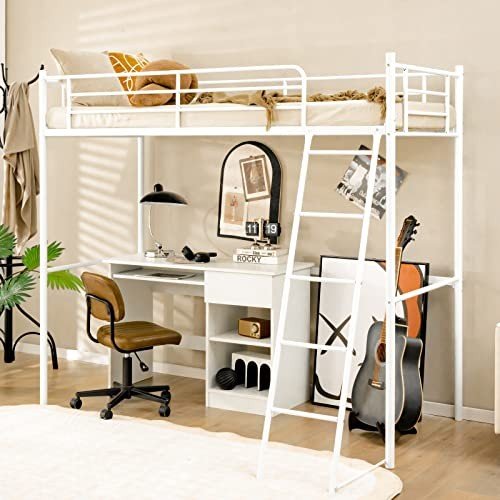Sale Bunk Bed
- Social Links:
Overview
-
Sectors Finance
-
Posted Jobs 0
-
Viewed 16
Company Description
Nine Things That Your Parent Teach You About Bunk Bed For Kids
The Ultimate Guide to Bunk Beds for Kids: Safety, Styles, and Solutions
Bunk beds have long been a popular option among moms and dads looking for to optimize space in their kids’s bed rooms. With advantages that surpass their compact style, bunk beds offer a fun and practical sleeping arrangement while encouraging brother or sister bonding and cultivating imagination. In this detailed guide, we check out different elements of bunk beds for kids, consisting of safety factors to consider, different designs readily available, and suggestions for picking the best one for your family.
Why Choose Bunk Beds?
Bunk beds are designed to stack one bed on top of another, utilizing vertical space to produce more space for play and storage. They are especially useful for households with numerous children or limited bed room space. Additionally, they provide an adventurous sleeping environment that kids typically enjoy.

Secret Advantages of Bunk Beds:
- Space-saving design: Ideal for little spaces or shared spaces.
- Affordable: Often more inexpensive than purchasing two separate beds.
- Encourages social interaction: Promotes bonding among siblings or friends.
- Flexible options: Available in numerous designs and configurations to suit any space style.
Safety First: Essential Considerations
When choosing a bunk bed for kids, security needs to be the top priority. The following features are vital for making sure a protected sleeping environment:
Important Safety Features:
- Sturdy Construction: Ensure that the bed frame is made of resilient products such as solid wood or metal.
- Guardrails: Bunk beds ought to have guardrails on both sides of the upper bunk to prevent falls.
- Ladder Safety: A tough, integrated ladder or stairs with anti-slip rungs is essential for safe access to the leading bunk.
- Weight Limit: Check the manufacturer’s weight limitation capacity for both the leading and bottom bunk.
- Mattress Size: Use the right mattress size as specified by the bed producer to make sure a tight fit within the bed frame.
Security Tips for Parents:
- Monitor Sleep Habits: Teach kids the importance of not using or leaping off the bunk beds.
- Age Appropriateness: Generally, the upper bunk appropriates for children aged 6 and older.
- Routine Inspections: Periodically check for any loose bolts, screws, or structural damage.
Styles of Bunk Beds
Bunk beds come in a variety of designs, permitting parents to select one that complements their child’s space design while meeting particular needs. Below are some popular designs:
Popular Bunk Bed Styles:
- Traditional Bunk Beds: Simple and classic designs made from wood or metal with no additional functions.
- Loft Beds: Features a raised leading bunk with space beneath for a desk, play location, or additional storage.
- L-Shaped Bunk Beds: Arranged in an L-shape, frequently perfect for corner spaces and can have extra storage choices.
- Twin over Full Bunk Beds: A twin bed on top and a bigger full-sized bed on the bottom, accommodating kids or teens of different ages.
- Triple Bunk Beds: Designed to fit 3 beds in a single footprint, ideal for larger families or pajama parties.
A Comparison of Bunk Bed Styles
| Bunk Bed Style | Description | Best For |
|---|---|---|
| Traditional | Classic design with 2 stacked beds | Standard bedroom setups |
| Loft Bed | Raised bed with usable space below | Homework or play locations |
| L-Shaped | Bunk beds organized in an L-shape | Corner spaces |
| Twin over Full | Twin bed on top, complete bed listed below | Various age siblings |
| Triple Bunk | Three stacked beds | Big families or pajama parties |
Picking the Right Bunk Bed
When looking for the ideal bunk bed, think about the following aspects to guarantee you make an informed choice:

Key Factors to Consider:
- Room Size: Measure the room dimensions to determine the proper size and height of the bunk bed.
- Child’s Age: Consider the age of your kid(ren) when choosing a style and safety functions.
- Functionality: Think about just how much storage or play space you require and whether the bunk bed should serve additional purposes.
- Budget: Set a budget plan that consists of not just the bunk bed however also the needed mattress and devices like bed linen or safety gates.
FAQs About Bunk Beds for Kids
1. What age is appropriate for a child to sleep in the leading bunk?
Usually, children aged 6 and older must have the ability to securely sleep in the top bunk, though you ought to constantly consider your kid’s maturity level.
2. Are bunk beds safe for toddlers?
It is not suggested for young children or extremely kids to sleep in the leading bunk due to the danger of falling.
3. How do I maintain the bunk bed?
Examine the bed routinely for any indications of wear and tear, tightening screws, and cleaning up the bed mattress to ensure extended security and durability.
4. Can I convert a bunk bed into two different beds?
Lots of bunk beds are created to be convertible, enabling you to separate the beds when needed. Inspect the maker’s specs before acquiring.
5. How can I make the most of space in a bunk bed space?
Make use of under-bed drawers, shelves, or lofted designs to produce additional storage options in a space with a bunk bed.
Bunk beds provide a wonderful mix of fun, performance, and space-saving energy, making them a perfect option for young households. By considering safety functions, various designs, and practical factors such as room size and age appropriateness, parents can select the ideal bunk bed for their child’s requirements. With the ideal choice, bunk beds can change a bed room into a magical space that encourages play, imagination, and bonding among siblings. Constantly keep in mind to prioritize security and maintenance to make the most of this distinct sleeping arrangement.
